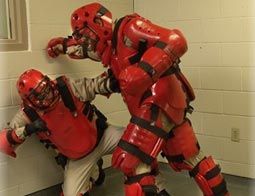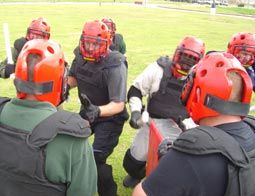 |
All too often I hear about administrations that care more for their public image than for their officers’ safety. This is a dangerous mistake. Frequently, officers on the floor will recognize the need for personal protection when administrators cannot. Officers will remember someone who has previously demonstrated the ability to cause serious injury. They will know their subjects’ emotional problems, behavioral issues and other violent disorders and they may even have sustained some kind of injury when dealing with certain subjects in the past.
Recently, an officer asked me about the need for justification when deciding whether to wear protective gear for supervising subjects inside a mental hospital. It was clear that the officer knew he needed to protect his team from the potential for blunt force trauma, yet the administration did not want to approve the use of gear because this would risk damaging their public image.
The bottom line is that, in any circumstance, protective gear is designed to protect the officer and that officer safety should ALWAYS come before public image. I understand the administrators’ concern, especially when public image plays a sensitive role in their facility. However, safety should override public relations in every situation.
What to wear and when to wear it
Usually, if an officer is questioning whether they should be wearing protective equipment, it means they should be. This includes (but is certainly not limited to) the following circumstances:
• Cell extractions or force cell moves
• CERT or SORT operations
• Any high risk threat
Gary T. Klugiewicz, an expert I’ve referred to many times in my career, puts it like this: “The one thing I’ve discovered is that protective equipment - both protective suits and soft training bags - reduce physical confrontations. The show of force allows the subject to give up and, in turn, reduces injuries to both staff and patients.”
It is important to realize that, alongside protective gear, a primary component of keeping everyone safe is tactical communications, Klugiewicz says. This means training your staff members how to talk and respond to irrational inmates and how to best build methods of communication that can limit, and possibly even stop, a physical confrontation.
It is also important to recognize the need for soft restraint training, which enables your officers to use restraint systems that can be safer, softer and more manageable than more aggressive gear. With this in mind, I would avoid riot gear unless absolutely necessary. The hard plastic shell can injure both the wearer and the person they are controlling.
Remember, there are many levels of protective gear and not all gear gives the wearer full protection. Just because something covers a designated area, this does not mean it will protect you from blunt force trauma. This is a dangerous misconception many people have when looking at protective gear.
 |
Here are some examples of useful personal protection:
• Striking shields: These are thick foam pads that staff members can use to create a barrier between the patient and themselves and to stabilize a violent or combative patient. The great thing about striking shields is that they are incredibly safe. They are soft enough to protect a patient who slams into them and they can be safely and effectively used to bump a patient with a technique called “pad subduing”, developed by Klugiewicz.
• Personal foundation gear: This is basic, lightweight protection worn underneath the uniform. It is designed to protect the wearer on bony and joint areas. Examples include:
1.) Groin protectors
2.) Knee pads
3.) Shin pads
4.) Elbow pads
5.) Mouth pieces• Closed cell foam protective gear: This gear is modular and gives the wearer protection in the areas they need to protect. It is easy to clean, decontaminate and sanitize. It comes in various colors like the RedMan. I would recommend using white.
Maintaining and repairing gear:
• Most gear should be stored in a cool dry place.
• I would stay away from gear you cannot fix on the spot or safely sanitize for hygiene purposes. Many officers have gotten body rashes, ring worm and other deceases from using improperly sanitized gear. Many times it takes more then water mixed with bleach to do the job!
• The following types of gear can be repaired on the spot and are worn externally, allowing for quick donning before entering dangerous areas:
1. Head protection with plastic or metal cage
2. Safety goggles
3. Mouth piece
4. Groin guard
5. Knee and shin protection
6. Arm guards
7. Thigh guards
8. Lower abdominal protection
9. Rear guard
10. Spinal protection
11. Foot guard
And remember, no matter where you are working, ensuring your officers are properly trained in the use of the gear they need is vital to the success of any mission.












